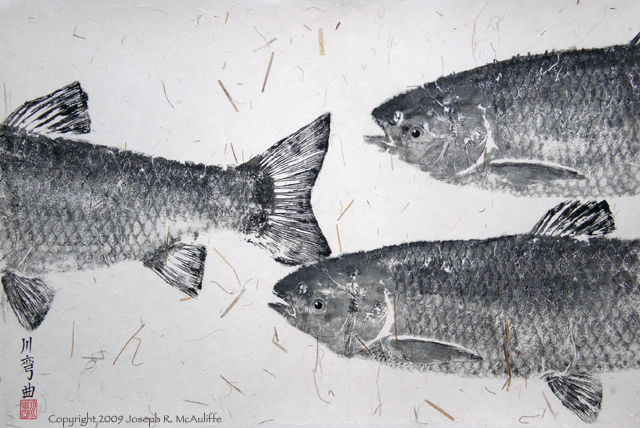
The Crosscut Canal is a small part of 131 miles of the Salt River Project canal system that delivers water to metropolitan Phoenix, Arizona. This large urban area is located in the hot, dry Sonoran Desert. Reservoirs on the Salt and Verde Rivers that drain the moister, forested high country provide water that flows through these canals year-round. This water is what makes it possible for over three and a half million people in "Valley of the Sun" to live here.
The Salt River Project (SRP) annually delivers 326 billion gallons of water through this extensive canal system. However, nature has a way of interfering with humankind's designs. As the season warms in late spring through summer, dense growth of aquatic plants and algae can clog the canals, seriously impeding the flow and delivery of water. In the past, costly efforts including mechanical removal and application of herbicides were used to control the unwanted growth of aquatic "weeds." None of those methods worked very well, and offered only temporary solutions. Furthermore, the use of chemical herbicides in the drinking water supply could have unintended, harmful effects on humans and other living things. In 1989 a different solution was tried, one that worked with nature rather than against her. A completely herbivorous fish, the white Amur or grass carp (Ctenopharyngodon idella), a native of Asia, was introduced into the canal system in an attempt to control the growth of aquatic plants. A white Amur can eat three-quarters of its weight in plant material per day. They can reach weights of up to 40 pounds. This program has been tremendously successful. By 1995, 23,000 white amurs swam in SRP canals, saving an estimated expense of $100,000 a year in the cost of chemicals once used to control unwanted plant growth. Canals that were formerly choked with aquatic vegetation 20 years ago are now free of any obstruction to the flow and delivery of water.
The white Amur introduced into the SRP canals are sterile and cannot reproduce. The use of sterile fish prevents this non-native species from reproducing and spreading to waters where it might have unintended and undesirable consequences. Sterile fish are produced by subjecting fertilized eggs to either pressure or heat. The stress of this treatment causes the embryo to develop with three sets of chromosomes instead of the normal two. These triploid fish are indistinguishable in external appearance from their normal diploid parents. However, the blood cells of triploid fish are slightly larger than those of diploids and examination of a blood sample is used to verify whether or not a fish is a sterile triploid.
Since the white Amur in the canal cannot reproduce, the Salt River Project stocks the canals with several thousand of them every year to replace 15 to 20% of the population that is lost annually. Those replacement fish are purchased from fish farms in Arkansas. At over $15 a fish, this adds up to no small expense and the white Amur in the canals are treated as special, protected livestock in service of humankind. Since it is a native of China, I sometimes think of these big and strong, but sterile fish carrying out their appointed task as privileged eunuchs like those that dutifully served the imperial court of ancient China. Although fishing is allowed in the canals, any white Amur caught must be immediately released, unharmed. Each year, SRP work crews drain parts of the canal system for cleaning and maintenance. When this occurs, the crews conduct a roundup by netting the precious white Amur and moving them to portions of the canal system that retain water. Collectively, thousands of white Amur in the canals silently carry on their work, ensuring an unobstructed flow of life-giving water to the millions of taps throughout the Phoenix area.

This is a gyotaku made from multiple prints of a single white Amur from the Crosscut Canal. I found the 34 inch-long fish dead and floating on the surface. Although I've had the thrill of catching several large white Amur in the canal with rod and reel over the years, I released all of them unharmed as required by law. I don't know what killed this fish, but it had not been dead for long when I found it, so I retrieved it in order to create this composition.
3 panels, each 37 x 24 inches (2009)
Return to Gallery 7.